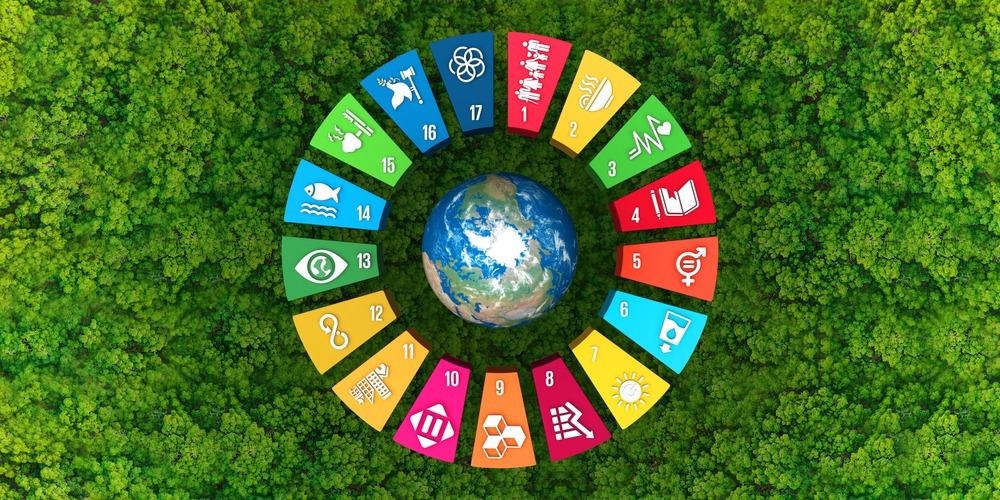
Image Credit: MintBlac/Shutterstock.com
Land Degradation
One of these important goals is maintaining and extending land quality while halting and reversing land degradation and desertification. More than 90% of human food is from land-based ecosystems, as well as our energy, building materials, clothes, medical substances, water for daily use, and clean air. Soil also uses up a major part of the carbon dioxide produced every day, alleviating its effects on climate change.
Healthy land ecosystems also modulate the impact of natural catastrophes such as droughts, floods, and earthquakes. The need for forestation and reforestation is obvious. Yet simply planting something green on near-desert land is simply not an option. The aim is to plant what will create a resilient and healthy environment that promotes natural biodiversity while functioning normally.
At the same time, it is necessary to raise safeguards against land-grabbing by business interests using the pretext of sustainable land development. The efforts to protect and restore land health must be based on a sound knowledge of what is good for the land, as well as for the people who depend directly on the land for their sustenance.
Local people must be involved in caring for the land they live on, rather than only policymakers or scientists, for an integrated and fruitful approach to land restoration.
Agricultural research should be tailored to increase the yield of poor farmers with small holdings, rather than being geared toward large-scale agro-industrial interests. Traditional agriculture and conservation agriculture should be promoted to mitigate the effects of climate change.
Experts in the field should be present to guide the actions taken into a sustainable and productive path, as well as ensuring they comply with local, national, and global policy frameworks. Ecosystem-based adaptation is preferable wherever possible.
Fossil Fuels
Another important area that needs to be strictly regulated is the use of fossil fuels, mostly for industrial, energy, and transportation needs. Both the production and the use of fossil fuels are grossly polluting the earth.
The pull toward fossil fuels is simply explained. These represent some of the most efficient and plentiful combustible resources in the world while advancing technology continues to make its production more cost-effective. Most of the oil produced in the world today is used for transportation because it made the internal combustion engine possible. Most of the coal produced today powers the production of electricity.
Yet, large-scale fossil fuel use has led to billions of dollars worth of economic damage by helping to precipitate global warming. The buildup of carbon and other greenhouse gases in the atmosphere is straining the resilience of the system past its breaking point.
This is why action is required now, rather than later, when still more strict restrictions will become inevitable.
Replace
Working on economically feasible storage solutions for energy excess is another area that requires development. Transportation should switch to active transport, by walking or cycling, where feasible, this being healthier for the individual as well as the planet. Where motor transport is required, carpooling or motorbike use should be the first choice.
Efficient heating and cooling technology should be mandated.
Renewable Fuels
Reducing the use of fossil fuels implies switching to electrification wherever possible, and getting the electric charge itself from zero-carbon energy sources such as wind or solar-powered plants. Fluctuating between locations depending on the availability of wind or sunlight at each site could help build a resilient supply.
Large-scale shipping by huge trucks or ships is not immediately replaceable by electric energy, because of the 40-times-higher energy density of fossil fuels that allows the means of transportation to be much more dependable and cost-effective than the corresponding electric form. To solve this, biofuels could be produced from plants, but when the carbon emissions from corn transport and conversion to fuel are accounted for, the savings come to less than 40% vs gasoline. This does not account for land use.
Waste from farm crops or municipalities can be converted into fuel too, but enhanced technology is urgently needed to make this a cost-effective option. Renewable electricity can be used to produce hydrogen from water so that it can be burnt for fuel. However, this is an energy-intensive process and less than ideal.

Image Credit: Olivier Le Moal/Shutterstock.com
Carbon Capture
Carbon capture and storage/use/release is the final option. Captured carbon or carbon dioxide removed from the ambient air could be injected deep underground, reused in another industrial process such as enhancing the recovery of oil from an almost used-up oil well, for instance, to displace the remaining oil from deep underground.
By using up the produced carbon dioxide this way, it could even shift the balance to the negative side, allowing for the use of carbon-rich fuels where they cannot be replaced, as in ships and aircraft. Carbon capture is attractive in being the least expensive way to deal with heavy industry emissions due to combustion, or from the industrial process itself.
“We have to remember that fossil fuels are not the ultimate cause of the problem — CO2 emissions are. If maintaining some fossil fuel use with carbon capture is the easiest way to deal with certain sources of emissions, that’s still solving the fundamental problem.”
Plant-Based Diet
One study shows that shifting away from animal-based diets to one that is plant-based could increase the global food supply by half using the same acreage, but at a significantly reduced carbon footprint and with less waste generation.
It is estimated that the carbon footprint of animal husbandry is equivalent to that of transportation. Calorie for calorie, 11 times as much fossil fuel use is required to produce animal protein as for plant protein. This is because, on a weight-for-weight basis, animal-based foods require much more water and carbon to produce than plant-based foods such as grains, seeds, and legumes.
Beef and milk require 2,000-8,000 gallons, and ~2,000 gallons, of water per pound and gallon produced, respectively, mostly for grass and grain feed, for 100 g/130 g protein per pound. A pound each of unprocessed oats and soybean curd (tofu) requires only 300 gallons, yielding 75 g/55 g protein per pound, respectively.
Ecosystem Adaptation
Ecosystems must be protected and restored, and sustainable management put in place, covering areas like agroforestry, increasing crop diversity, and better water and soil management. Earlier planting and changing crop varieties, shifting to heat- and drought-tolerant varieties in high-risk regions, and tree planting in pastures are other examples.
This step can mitigate extreme weather events while promoting biodiversity, and protecting livelihood and food security, simultaneously reducing carbon emissions.
Protecting patches of natural habitat (including marshland, peatland, wetlands, mangroves, salt marshes, etc.) while encouraging connectivity between them, coastal zone management, and ensuring sustainable forest management and aquaculture, are other adaptation techniques to protect the ecosystem. protection and restoration of
Local communities should adopt their beaches, streams, and other natural resources, taking care of them and sustainably developing them. Tourism and related activities should be regulated to protect the environment while promoting the enjoyment of nature.
Plastic Pollution
Over 90% of plastic waste in the world is not recycled. To reduce the amount of waste produced daily, disposable food-grade plastics could be swapped out for durable hygienic reusable items. Avoiding bottled water would avert the use of fossil fuels to transport water, among the heaviest substances that can be carried.
Collaborative Action
For such changes to become real universally, though, the major shift required is political. This is the hardest to make, since politicians inevitably focus on the short term, while investments in replacing fossil fuels are both heavy and associated with uncertain gains in the long term.
Facilitating clean development in the developing world is as important as reducing and replacing fossil fuels in the developed and wealthy world. If this is not done, developing countries will inevitably leave the same heavy carbon footprint on the world as they seek economic prosperity. Besides shifting to zero-carbon electricity and light vehicle manufacture, energy-conserving buildings must become mandatory everywhere new construction is happening.
International treaties and agreements are of prime importance. Activists play a key role here, as they are free from merely domestic concerns, being able to view the matter of environmental and public health from a globally relevant and responsible perspective.
However, environmental policies, as well as strategies for economic, social or environmental development, are usually based on considerations other than health. This requires to be changed, equipping people with climate literacy and the cost of unregulated development, as well as the environmental cost of their actions in obtaining food, water, and energy.
Up to $300 billion could be needed each year for developing countries to handle climate change by 2050. Approximately 170 countries have climate adaptation policies already, but most are only on paper.
To take this forward, policymakers at all levels must make it a top priority to provide technical and financial support for environment-friendly planning and development in all fields of governance. This will include educating all stakeholders, globally and nationally, as well as at the state and community level, on the centrality of health and sustainable development to good planning.

Image Credit: petrmalinak/Shutterstock.com
The Way Ahead
An important fact that is little known is that climate change already costs billions of dollars in harm to human health. Some actions must be taken irrespective of whether or not the feared outcomes materialize or not.
Called no-regrets measures, these include community food supply that is robust to disruptions, reliable medical supply chains, incorporating required technology and tools, providing better and more advanced training for staff, and setting up a buffer against the breakdown of health services in the face of unexpected extreme events.
Social protection programs that provide a safety net for the most vulnerable and weakest sections must be set up, with partnerships between governments, civil organizations, and the private sector.
And finally, newer technologies should be taken into account to couple with more natural solutions, reduce climate-related risks, and promote resilience. This could include biotechnology in the service of animal husbandry or renewable energy from the sun or wind. Careful assessments are necessary to make sure the solution is not worse than the problem.
Numerous warnings and recommendations have been made by scientists, including the Intergovernmental Panel on Climate Change (IPCC) in its latest report in 2022.
“Coming to grips with the climate crisis will not be easy. Governments, civil society, and the private sector must all step up. As the IPCC report makes clear, there is no alternative.”
References:
- Climate Change 2022: Impacts, Adaptation and Vulnerability. https://www.ipcc.ch/report/ar6/wg2/
- Bridgewater, P. et al. (2012). Healthy Planet, Healthy People ‐ A Guide to Human Health and Biodiversity. Secretariat of the Convention on Biological Diversity, Montreal.
- Orradottir, B. et al. (2015). Healthy Ecosystems, Healthy Earth, Healthy People. https://unu.edu/publications/articles/healthy-ecosystems-earth-people.html.
- Why are fossil fuels so hard to quit? (2020). https://www.brookings.edu/essay/why-are-fossil-fuels-so-hard-to-quit/
- Beckett, J. L. et al. (1993). Estimation of the Water Requirement for Beef Production in the United States. Journal of Animal Science. https://pubmed.ncbi.nlm.nih.gov/8478283/. https://doi.org/10.2527/1993.714818x
- Hunnes, D. (2022). The Case for Plant Based. https://www.sustain.ucla.edu/food-systems/the-case-for-plant-based/
- Thome, J. (2021). For The Love of The Planet and Your Health, Eat Sustainably. https://news.illinoisstate.edu/2020/04/for-the-love-of-the-planet-and-your-health-eat-sustainably/
- Make Every Day Earth Day (2019). https://scdhec.gov/environment/make-every-day-earth-day
- Tye, S. (2021). How Climate Change Affects Health and How Countries Can Respond. https://www.wri.org/insights/how-climate-change-affects-human-health-countries
- Levin, K. et al. (2022). 6 Big Findings from the IPCC 2022 Report on Climate Impacts, Adaptation and Vulnerability. https://www.wri.org/insights/ipcc-report-2022-climate-impacts-adaptation-vulnerability
Further Reading
- All Global Health Content
- The Impacts of War on Global Health
- How Can We Achieve Equal Global Health Access?
- The Impacts of Humanitarian Crises on Global Health
- Public Health and Global Inequalities
Last Updated: Mar 31, 2022

Written by
Dr. Liji Thomas
Dr. Liji Thomas is an OB-GYN, who graduated from the Government Medical College, University of Calicut, Kerala, in 2001. Liji practiced as a full-time consultant in obstetrics/gynecology in a private hospital for a few years following her graduation. She has counseled hundreds of patients facing issues from pregnancy-related problems and infertility, and has been in charge of over 2,000 deliveries, striving always to achieve a normal delivery rather than operative.
Source: Read Full Article